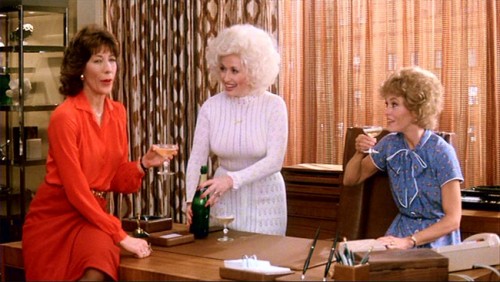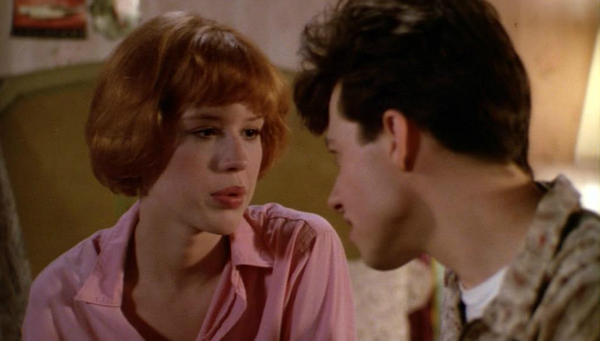This guest post by Deb Rox appears as part of our theme week on Female Friendship.
Forget “leaning in.” To thrive in a corporate environment you need work BFFs who will do three things for you: mentor you up the ladder, make sure you are included in an lunch order if someone is arranging delivery, and help you blackmail your boss should it come to that.
Work friendships between women are sacred. Office friends serve as your career siblings. They are essential playmates who share the chores of daily living, and more importantly, bear witness to the same dysfunctions and deadlines. Good work friends will evolve lines of gossip (institutional and interpersonal, both matter) and ways to process everything from office memos to the bizarre co-workers who are not your friends. All of this is amped up in bad and equitable work situations where women need friends to help bust ass and glass ceilings, and to simply survive.
Movies take on the theme of office friendships, but great representations of women friend are few and far between. Wall Street and tech movies are boytown. Office Space is the go-to classic for illuminating oppressive corporate cubicle life, but it doesn’t come close to passing the Bechdel Test. I love Jennifer Aniston as much as the next flair-hater, but she’s in Office Space as a complicated love interest and to represent service work, the “feminine” version of tech work in this film’s universe. She is there to be dated and to be saved. She is not there to make friends – nor does she have any.
Other movies offer working girls friends but only as side plots (Melanie Griffin had Joan Cusack in Working Girl) or they only offer frenemies (think of poor Anne Hathaway in The Devil Wears Prada and how she had to settle for glimpses of kinship, and at the end of the movie at that. )
In fact, Anne’s Andy needed a girl gang in the magazine office more than she needed a couture hook-up. What she needed – and what I needed again and again in various horrible job situations – was the ultimate project team as realized in the 1980 triumph 9 to 5. She needed Doralee (Dolly Parton), Violet (Lily Tomlin) and Judy (Jane Fonda,)
Incredibly radical for its time, 9 to 5 has become the standard by which all of workplace friendships on and off screen are measured. These women are gold. GOLD. Would you help me steal a body from the morgue? Would you hogtie our boss to keep him from calling the cops on me? Would you help me enact the progressive, women-centered policies I dream of bringing to our workplace? If your answer is “no,” don’t bother asking me to help you proofread your latest pivot table. What I need is real women friendships at work. Friends like Violet, Judy and Doralee.
The friendships in 9 to 5 are like what would happen if Lucy and Ethel paused halfway on the road to becoming Thelma & Louise. The holy trinity are really more akin to wartime combat buddies than to anything else. At the start of the film the women are fairly wary of each other, battle broken as they are from their individual struggles. Doralee, Violet, and Judy probably wouldn’t be friends in if they weren’t thrown together into the battle of Frank Hart Jr.’s (Dabney Coleman) corrosive workplace.
The sad thing about the first act, which is brilliantly exacted, is that they see each other through the lens of the decidedly exploitive, sexist office environment – and they don’t like what they see. Of course they don’t. In that nasty patriarchal universe defined by Hart they are reductive stereotypes: the slut, the shrew, the out-of-place housewife. They fall prey to gossip and suspect the very-Dolly Doralee of sleeping with the boss (ew, that mustache). Violet, a newly divorced and rather meek character at first, is viewed as a drain on mega-competent Judy. Judy is bitter (rightfully so) about the way she’s been passed over repeatedly in the sexist environment.
The brilliance of 9 to 5 is how the story inverts all of that. It upturns Hart’s universe and it also reverses how the characters see themselves and each other. In doing so it makes an environment of female friendship possible and necessary, and it is absolutely gleeful to to see those barriers dissolve as the women start to bond and start to see themselves as on the same team. It’s genius, really, the way it shows that stereotypes are limiting, destructive and wholly created by sick systems. In 9 to 5, sexist systems are personified by Hart, who was, as Doralee put it, “evil to the core.”
The turning point of the movie, and of their friendship, takes place in Doralee’s house. They end up pissed off on behalf of the mistreatment sleazy Frank Hart imposes. They each take a few hits of some primo ‘80s Maui Wowie and take turns narrating revenge fantasies. These scenes are fabulous, with Hart shown hunted and trapped on a toilet in the women’s bathroom and hog-tied and roasted on a spit. Doralee, giving him a taste of his harassment, calls him “my boy from 9 to 5.” Animated blue birds of happiness help Judy poison Hart in her gruesomely delicious fairy tale, and happiness befalls the kingdom when the king falls through the window to the sidewalk below.
Like the three fates, the friends conjure a life-altering force by listening to each other, by laughing, by being friends. The scenes where they envisioned the demise of their “sexist, egotistical, lying, hypocritical bigot” of a boss start to play out for real in madcap, accidental, and intentional ways. As the fabric unrolls, each woman experiences being supported by the other two and feels compelled to help her friends. In their confusions, cover-ups, and retribution schemes, Violet, Doralee, and Judy knit together a solid friendship where each character finds strength and support. And manage to avoid getting caught. It’s the little things.
The misandric revenge factor is fun, but the serious power in 9 to 5 happens when the friends begin making changes in the office. Judy, bolstered by her fabulous management team, is a better leader than Hart could ever be, and together they bring in every progressive workplace program imaginable in 1980. These legit moves are more rewarding than any of the hog-tying scenes because women do dream of these changes, we do work together to make them happen, and we want equity more than we want punishment. Well, reducing Hart to watching daytime television for company was pretty rewarding, too.
[youtube_sc url=”https://www.youtube.com/watch?v=LwDMFOLIHxU”]
9 to 5 knew we want good workplaces and good friends who are invested in our success just as we are invested in theirs. Wrapped in with all of the fantasy, in 9 to 5, female friendships were elevated as leverage against systemic organizational sexism, and as a positive factor for both individual empowerment and sustainable leadership. Almost every single scene supported this thesis except for those defining Hart’s character and a very few others that contextualized the character’s home lives. Mostly, though, this movie belonged to the bond forged by Doralee, Judy and Violet during their beautiful mutiny.
Watching the movie, you want these women as your friends. You want to get Violet stoned, you want to cheer as Doralee flawlessly twirls a lasso with her red-clawed, manicured hands, and you want to stay up all night writing new human resource policies for the corporation of your dreams with Judy. After watching 9 to 5 you’ll want to trade in your car for a bigger vehicle, one with a bench seat in the front big enough for all of your work BFFs and with a trunk big enough to conceal and carry your boss if happens to be a “sexist egotistical lying hypocritical bigot.” Should it ever come to that.
Deb Rox serves as Entertainment Editor of BlogHer where she writes about media, pop culture, and current events. She will vote for any political candidate who promises to unite the continent into one time zone for easier live-tweeting purposes. Follow her on her blog Deb on the Rocks and at @debontherocks on Twitter.
















